Discover 5 engaging indoor games for pets to keep your furry friends active and entertained during rainy days. These expert-approved activities promote physical and mental wellbeing!
Table of Contents
Introduction: Keeping Your Pet Active When Outdoor Play Isn’t an Option
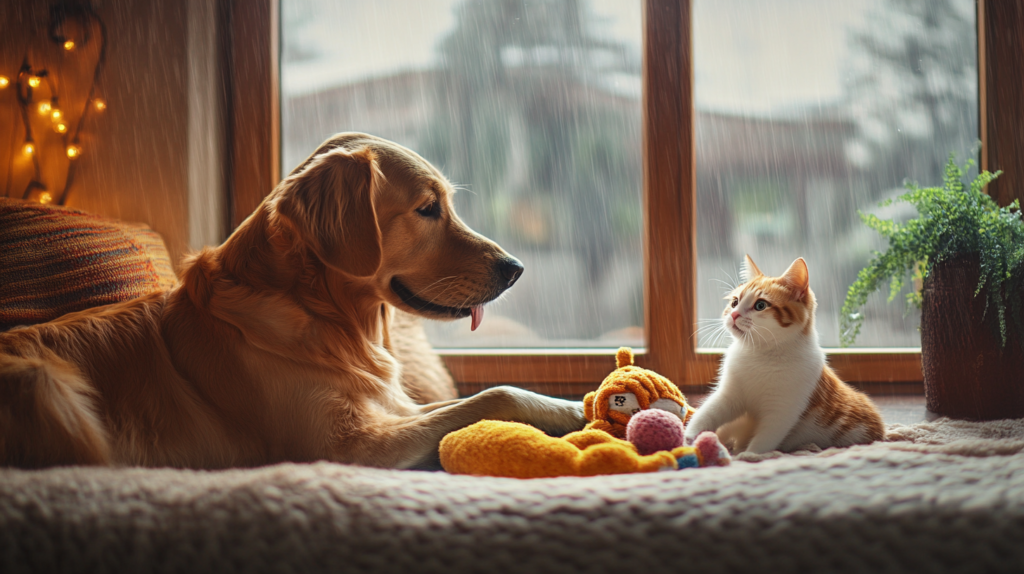
When rain clouds gather and outdoor adventures are postponed, pet owners face a common challenge: how to keep their furry companions physically active and mentally stimulated within the confines of home. Indoor games for pets aren’t just a rainy-day solution—they’re essential tools for maintaining your pet’s overall well-being regardless of weather conditions. According to the American Veterinary Medical Association, pets that engage in regular indoor play show reduced signs of anxiety, decreased destructive behaviors, and maintain healthier weights compared to their less-active counterparts.
Whether you have an energetic dog bouncing off the walls, a curious cat seeking entertainment, or even smaller pets like rabbits or ferrets, this comprehensive guide will introduce you to the five most engaging indoor games for pets that require minimal setup and maximum fun. We’ll explore activities suitable for various pet personalities, spaces, and energy levels, ensuring every pet parent finds the perfect indoor entertainment solution.
Let’s transform those dreary, wet days into opportunities for bonding, learning, and playful interaction with your beloved companions!
Why Indoor Play Matters for Pet Health
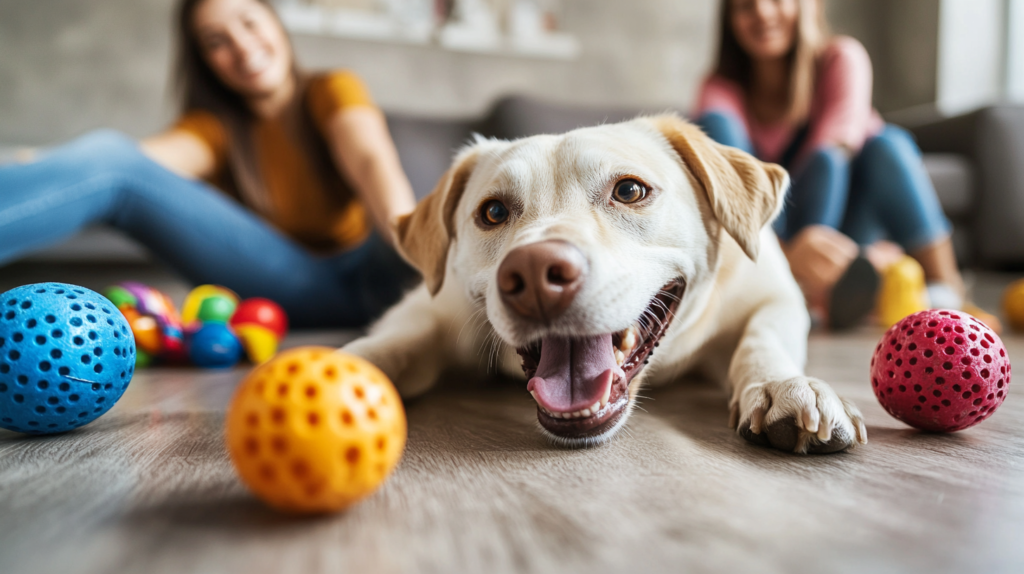
Before diving into specific games, it’s important to understand why indoor play is more than just a way to pass time—it’s a crucial component of your pet’s physical and mental health regimen.
Physical Benefits of Indoor Play
Indoor games for pets provide essential exercise that helps:
- Maintain healthy weight: According to a 2023 study by the Association for Pet Obesity Prevention, approximately 59% of dogs and 61% of cats in the United States are classified as overweight or obese. Regular indoor play can burn calories and help manage weight when outdoor walks are limited.
- Improve cardiovascular health: Dr. Sarah Wilson, veterinary cardiologist at Cornell University, notes that “Even short bursts of play can elevate your pet’s heart rate, improving circulation and overall cardiovascular function similar to moderate outdoor exercise.”
- Enhance coordination and agility: Games involving jumping, weaving, or balancing help pets develop better body awareness and motor skills.
Mental and Emotional Benefits
Beyond the physical advantages, indoor play offers significant psychological benefits:
- Prevents boredom and reduces anxiety: A survey conducted by the Journal of Veterinary Behavior found that pets who engaged in at least 20 minutes of interactive play daily showed 35% fewer signs of separation anxiety and stress-related behaviors.
- Strengthens the human-animal bond: Dr. James Serpell, Professor of Animal Ethics at the University of Pennsylvania, explains that “Play is a universal language that transcends species barriers. When we play with our pets, we’re communicating in a way they intrinsically understand, strengthening trust and affection.”
- Provides cognitive stimulation: Problem-solving games can delay cognitive decline in aging pets, with one study showing that older dogs who regularly engaged in puzzle games maintained sharper cognitive abilities than their non-playing counterparts.
Now that we understand the importance of indoor play, let’s explore our top five indoor games for pets that will keep tails wagging and whiskers twitching even on the gloomiest days.
Game 1: Treasure Hunt – A Scent-Based Adventure
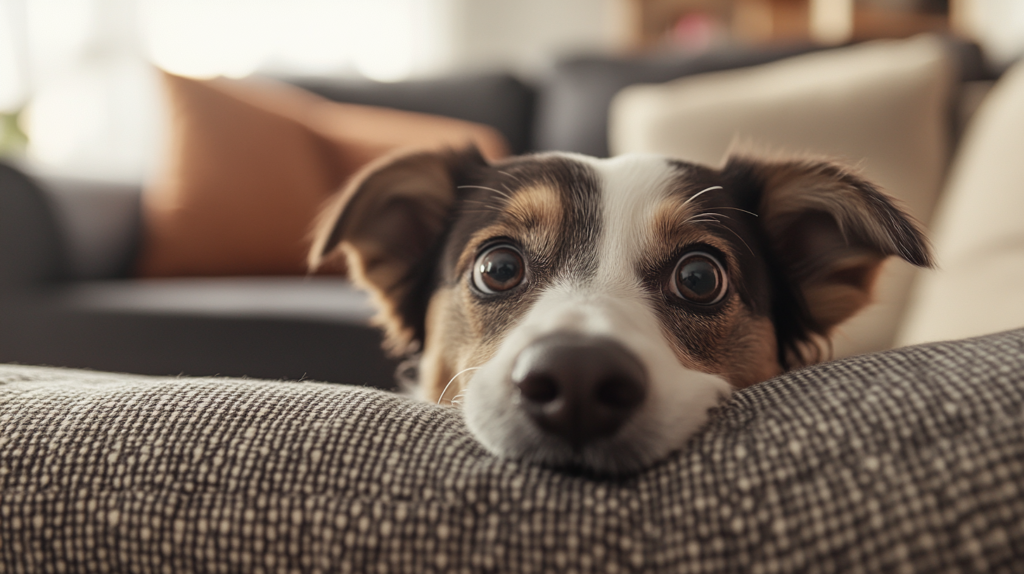
Treasure hunts tap into your pet’s natural foraging instincts and provide excellent mental stimulation through their powerful sense of smell.
How to Set Up a Pet Treasure Hunt
For Dogs:
- Gather small, fragrant treats or pieces of your dog’s favorite kibble.
- Have your dog sit and stay in one room (or have someone hold them).
- Hide treats throughout another room, starting with easy-to-find locations.
- Use the command “Find it!” or “Seek!” to release your dog to begin hunting.
- As your dog becomes more skilled, increase the difficulty by hiding treats in more challenging spots.
For Cats:
- Use small portions of freeze-dried treats or catnip-filled toys.
- Hide these treasures in locations that encourage climbing, jumping, and exploring.
- Place some treats inside crumpled paper or partially concealed under pet-safe objects to add challenge.
For Small Pets:
- Create a foraging course in a secure playpen using paper tubes, pet-safe boxes, and tunnels.
- Hide small treats, fresh veggies, or favorite foods throughout the course.
- Supervise your small pet as they discover and enjoy their treasures.
Benefits of Treasure Hunt Games
Dr. Alexandra Horowitz, author of “Inside of a Dog: What Dogs See, Smell, and Know,” explains: “Scent games allow dogs to use their most developed sense—their sense of smell is at least 10,000 times more acute than ours. When we create opportunities for olfactory enrichment, we’re engaging the most significant way they experience and understand their world.”
A 2022 study published in Applied Animal Behaviour Science found that dogs who regularly participated in scent games showed increased problem-solving abilities and decreased stress markers compared to dogs who didn’t engage in scent work.
Expert Tip
Veterinary behaviorist Dr. Ellen Lindell recommends: “For anxious pets, start with very easy finds to build confidence. The goal is success and fun, not frustration. Gradually increase difficulty as your pet’s hunting skills improve.”
Game 2: DIY Obstacle Course – Indoor Agility Training
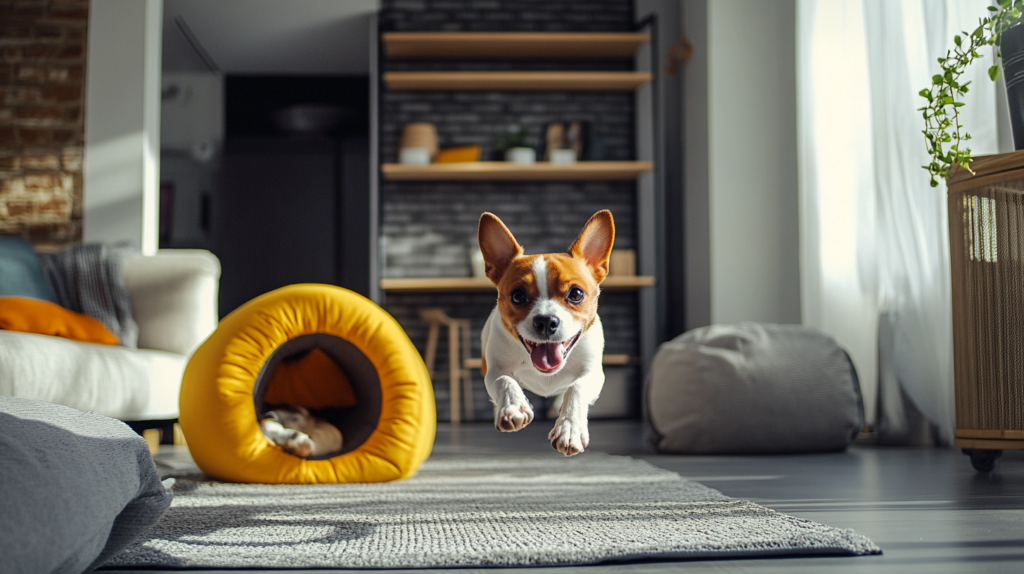
Transform your living space into a pet-friendly obstacle course that challenges your companion’s agility, focus, and physical abilities.
Creating Your Indoor Pet Obstacle Course
Materials You’ll Need:
- Couch cushions or pillows (for jumps)
- Empty cardboard boxes (for tunnels)
- Hula hoops (for jumping through)
- Kitchen chairs (for weaving)
- Blankets or sheets (for tunnel creation)
Setting Up Your Course:
- Design for your space: Map out a course that flows through available areas without creating hazards.
- Start simple: Begin with 3-4 obstacles and gradually expand as your pet gains confidence.
- Safety first: Ensure all obstacles are stable and appropriate for your pet’s size and ability level.
For Dogs:
Create a sequence like:
- Weave through 4-5 evenly spaced chairs
- Jump over a low stack of cushions
- Crawl through a blanket tunnel draped between furniture
- Jump through a hula hoop held a few inches off the ground
- Finish by touching a target (like a specific toy)
For Cats:
Design a more vertical challenge:
- Jump onto a stable ottoman
- Walk along the back of a couch
- Navigate through a paper bag tunnel
- Leap to a cat tree
- Find a treat hidden in a puzzle toy at the end
For Small Pets:
Create a miniature scaled version:
- Set up small tunnels made from paper towel rolls
- Create tiny ramps from cardboard
- Make hurdles from books with popsicle sticks across them
- End with a cozy hiding spot containing a favorite treat
Benefits of Obstacle Courses
Indoor obstacle courses provide exceptional physical and mental benefits:
- Full-body workout: Engages multiple muscle groups through jumping, crawling, and balancing activities.
- Improves focus: Teaches pets to follow directions and concentrate on completing tasks.
- Builds confidence: Mastering new challenges boosts your pet’s self-assurance and problem-solving abilities.
According to a 2023 survey by the American Pet Products Association, 73% of pet owners reported noticeable improvements in their pets’ coordination and attention span after regularly incorporating obstacle course play into their routine.
Expert Tip
Certified dog trainer Melissa Breau advises: “Use high-value rewards and enthusiastic praise when your pet successfully navigates each obstacle. Keep sessions short (5-10 minutes) but frequent for maximum engagement without fatigue or frustration.”
Game 3: Interactive Puzzle Toys – Mental Gymnastics for Pets
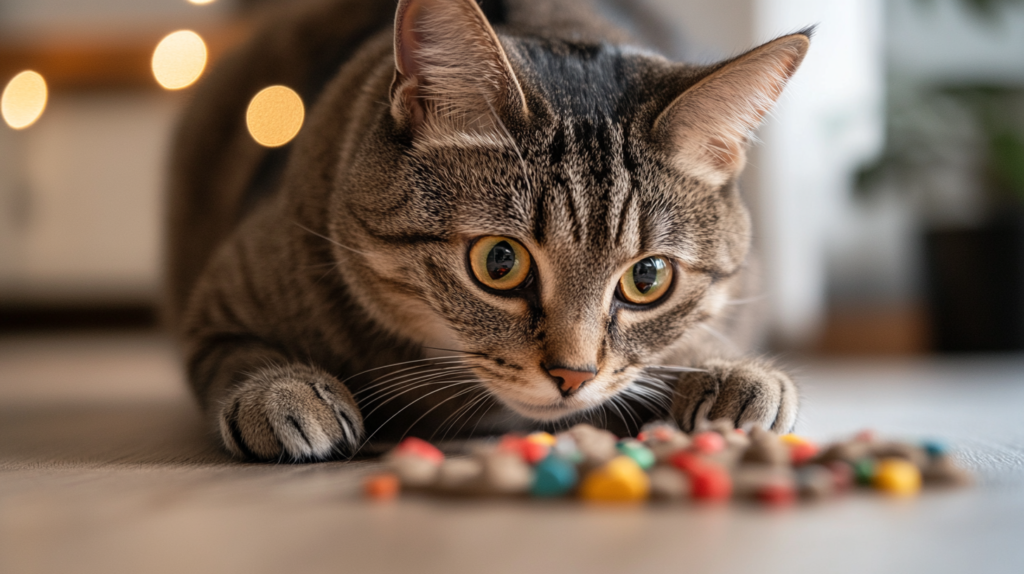
Puzzle toys offer outstanding mental stimulation by challenging your pet to solve problems to access treats or toys, keeping their mind sharp and engaged.
Top Puzzle Toy Options for Different Pets
For Dogs:
- Treat-dispensing balls: These toys release kibble or small treats as your dog pushes and rolls them around. The Nina Ottosson line of puzzle toys offers multiple difficulty levels.
- Lick mats: Spread a thin layer of pet-safe peanut butter, yogurt, or wet food on textured mats to create a long-lasting licking activity that soothes and engages.
- Snuffle mats: These fabric mats with numerous flaps and pockets hide treats for your dog to sniff out and find, engaging their natural foraging instincts.
For Cats:
- Food puzzles: Products like the PetSafe SlimCat dispenser make cats work for their kibble by pawing and batting at the toy.
- Interactive electronic toys: Self-moving toys with unpredictable movements mimic prey behavior, engaging your cat’s hunting instincts.
- Treat mazes: Flat puzzle boards with complicated paths challenge cats to fish out treats using their paws.
For Small Pets:
- Foraging toys: Rabbit-specific puzzle feeders hide pellets or vegetables, encouraging natural behaviors.
- Cardboard constructions: Create DIY puzzles with toilet paper tubes stuffed with hay and hidden treats for hamsters, guinea pigs, or rabbits.
DIY Puzzle Toys You Can Make at Home
For budget-friendly options, try these homemade puzzle toys:
- Muffin tin game: Place treats in the cups of a muffin tin and cover each with a tennis ball. Your pet must remove the balls to access the treats.
- Bottle spinner: Place small treats inside a clean plastic bottle with holes cut in the sides. Your pet will need to roll and manipulate the bottle to get the treats to fall out.
- Towel roll-up: Align treats along a towel, then roll it up like a Swiss roll. Your pet must unroll the towel to find the hidden treasures.
Benefits of Puzzle Toys
Research from the Companion Animal Psychology lab at Bristol University indicates that dogs who regularly use puzzle toys show:
- 30% reduction in destructive behaviors
- Improved problem-solving abilities on novel tasks
- Lower cortisol (stress hormone) levels
Dr. Tony Buffington, veterinarian and expert in environmental enrichment, notes: “Environmental enrichment through puzzle toys is as important to our pets’ wellbeing as proper nutrition and veterinary care. These toys satisfy the innate need to work for resources and provide a healthy outlet for energy that might otherwise be directed toward unwanted behaviors.”
Expert Tip
Animal behaviorist Dr. Karen Overall recommends: “Rotate puzzle toys regularly to maintain interest, and gradually increase difficulty as your pet masters each level. Always supervise play with puzzle toys, especially with new toys or those containing small parts.”
Game 4: Hide and Seek – The Classic Game Reimagined for Pets

Hide and seek isn’t just for children—it’s a fantastic indoor game for pets that builds recall skills, encourages bonding, and provides both mental and physical exercise.
How to Play Hide and Seek with Different Pets
For Dogs:
- Start by having your dog “stay” (have someone hold them if stay isn’t reliable).
- Show them their favorite toy or treat.
- Go hide in another room (start with easy hiding spots).
- Call your dog’s name excitedly or use your recall command.
- When they find you, reward with enthusiastic praise and the treat/toy.
- As they improve, increase the difficulty of your hiding spots.
For Cats:
- Cats often prefer to be the hiders rather than seekers, so try a modified approach.
- Create several hiding spots using boxes, paper bags, or cat tunnels.
- Use a wand toy or laser pointer to lead your cat between hiding spots.
- Reward discoveries with treats or play sessions.
- Alternatively, hide treats or catnip toys for your cat to discover.
For Small Pets:
- Create a supervised play area with multiple hiding options.
- Hide treats or favorite foods in different locations.
- Place your pet in the play area and watch as they discover hidden treasures.
Training Opportunities in Hide and Seek
This game provides excellent opportunities to reinforce important commands:
- Stay: Practice having your pet wait patiently while you hide.
- Come/Recall: Strengthen this crucial command by making “finding you” the goal of the game.
- Search/Seek: Teach a specific command for finding hidden objects or people.
Dr. Patricia McConnell, animal behaviorist and author, emphasizes: “Games like hide and seek tap into a dog’s natural predatory sequence—searching, stalking, chasing—in a positive, controlled way that strengthens your bond and reinforces training.”
Real-Life Applications
The skills developed during hide and seek translate to real-world scenarios:
- Improved recall for emergency situations
- Better focus in distracting environments
- Enhanced problem-solving when faced with challenges
A survey conducted by the American Kennel Club found that 87% of dog owners who regularly played hide and seek reported improved recall response in outdoor settings.
Expert Tip
Certified animal trainer Victoria Stilwell suggests: “Always end the game while your pet is still enthusiastic. Five minutes of focused, fun play is better than 15 minutes where your pet loses interest. This keeps the game special and exciting for next time.”
Game 5: Target Training – Precision Play for All Pets

Target training—teaching your pet to touch a specific object with their nose, paw, or body—is not only an engaging indoor game but also lays the foundation for more advanced tricks and behaviors.
Getting Started with Target Training
Basic Materials Needed:
- A targeting device (commercial target stick, wooden spoon, or even your hand)
- Small, high-value treats
- Clicker (optional but helpful)
For Dogs:
- Present the target near your dog’s nose.
- When they naturally investigate by sniffing or touching it, immediately mark the behavior (with a clicker or verbal “yes!”) and reward.
- Repeat until your dog deliberately touches the target when presented.
- Add a cue word like “touch” or “target” just before presenting the target.
- Gradually increase the distance between your dog and the target.
For Cats:
- Use a target stick with an interesting end (like a small pompom).
- Hold it near your cat’s nose or paw.
- Any interaction with the target earns immediate praise and treats.
- Progress slowly, as cats often need more time to understand the concept.
For Small Pets:
- Use a small, non-threatening target appropriate for your pet’s size.
- Place it near their favorite resting area.
- Reward any interaction, even proximity to the target initially.
Building Complex Games from Target Training
Once your pet understands the basic targeting concept, you can create more elaborate indoor games:
- Target Relay: Place multiple targets around a room and have your pet touch each one in sequence.
- Target Obstacle Course: Combine targeting with your DIY obstacle course by placing targets at key points.
- Target Hide and Seek: Hide targets throughout your home for your pet to find and touch.
- Target Simon Says: Teach different targets for different body parts (nose touch vs. paw touch) and alternate commands.
Benefits of Target Training
According to research published in the Journal of Applied Animal Welfare Science, target training offers multiple benefits:
- Precision training tool: Allows you to teach complex behaviors by breaking them down into manageable steps.
- Non-aversive method: Uses positive reinforcement rather than correction.
- Confidence builder: Particularly helpful for shy or anxious pets.
- Mental stimulation: Challenges your pet’s understanding of cause and effect.
Dr. Sophia Yin, renowned veterinary behaviorist, noted before her passing: “Target training is one of the most versatile and useful training techniques. It gives animals clear communication about exactly what we want them to do, reducing frustration and building confidence.”
Expert Tip
Professional animal trainer Ken Ramirez advises: “Keep target training sessions short (3-5 minutes) but conduct them multiple times throughout the day. Consistency and brevity are key to maintaining enthusiasm and preventing mental fatigue.”
Bonus Section: Tailoring Indoor Games to Your Pet’s Personality
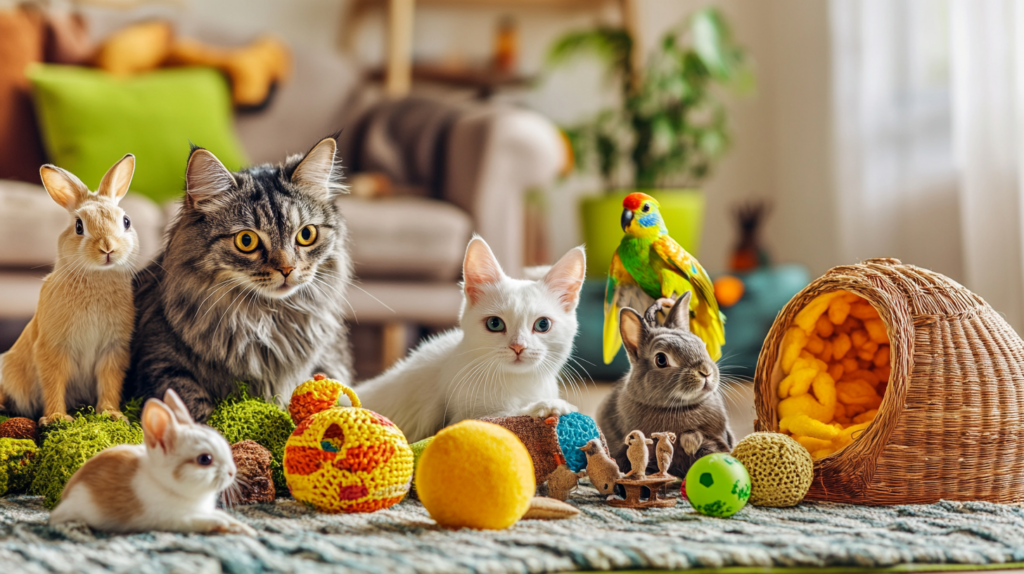
Every pet has a unique personality that influences what games they’ll enjoy most. Understanding your pet’s play style can help you select the most engaging activities.
For High-Energy Pets
Active, energetic pets thrive with games that provide physical outlets:
- Extended obstacle courses with multiple active stations
- Flirt pole play (for dogs) in open spaces
- Vigorous games of fetch with soft indoor toys
- Target training with lots of movement between targets
Expert Insight: Veterinary behaviorist Dr. Amy Marder suggests, “High-energy pets often need games that combine physical exertion with mental challenges. Simply running them ragged won’t satisfy their need for engagement—incorporate training elements into active play for best results.”
For Puzzle-Loving Pets
Thoughtful, problem-solving pets enjoy:
- Advanced food puzzles with multiple steps
- Scent discrimination games
- Interactive electronic toys that respond to their actions
- Hide and seek with increasingly difficult hiding spots
According to animal cognition researcher Dr. Brian Hare, “Some pets show particular aptitude for problem-solving tasks. These ‘canine Einsteins’ or ‘feline geniuses’ may become destructive if not given adequate mental challenges, as they’ll create their own puzzles—often with your belongings!”
For Cautious or Older Pets
Shy, anxious, or senior pets benefit from:
- Gentle treasure hunts with easily found items
- Simple target training with minimal movement
- Calm hide and seek games focusing on scent
- Low-intensity puzzle toys that don’t require much physical effort
A 2022 study in Veterinary Medicine and Science found that low-intensity cognitive games significantly improved quality of life measures in senior pets, with owners reporting improved alertness and decreased sleep disturbances.
Visual Guide: Matching Games to Pet Personalities
| Pet Personality Type | Best Games | Games to Avoid |
| High-Energy | Obstacle courses, Target relay, Advanced hide and seek | Long puzzle sessions requiring stillness |
| Analytical/Problem-Solver | Multi-step puzzles, Scent work, Memory games | Repetitive games with no increasing challenge |
| Cautious/Anxious | Simple targeting, Easy treasure hunts, Predictable routines | Loud or unpredictable games, Complex obstacles |
| Senior/Low-Mobility | Mental puzzles, Gentle scent games, Stationary targeting | High-impact activities, Complex physical challenges |
| Food-Motivated | Treat-dispensing puzzles, Lick mats, Scent games | Games without edible rewards may lose appeal |
Safety Considerations for Indoor Pet Play
While indoor games for pets provide excellent enrichment, safety should always be the priority. Here are crucial safety guidelines to follow:
Physical Space Considerations
- Clear the play area: Remove breakable items, toxic plants, electrical cords, and small objects that could be swallowed.
- Provide non-slip surfaces: Ensure your pet has proper footing during active play to prevent injuries, especially on hardwood or tile floors.
- Consider space limitations: Adapt games to fit your available space—apartment dwellers should focus more on mental games than large-scale physical activities.
Toy Safety Guidelines
- Size appropriately: All toys should be large enough that they can’t be swallowed whole or have pieces bitten off and ingested.
- Inspect regularly: Check toys for damage and discard any that are breaking down.
- Supervise play: Never leave pets unattended with new toys or puzzle games, especially those containing treats or small parts.
Pet-Specific Safety Concerns
- Know your pet’s limitations: Consider age, health conditions, and physical capabilities when selecting games.
- Watch for signs of stress: Panting, yawning, lip licking, or avoidance behaviors may indicate your pet needs a break.
- Manage multi-pet households: Ensure all pets have their own space for games to prevent resource guarding or competition.
According to emergency veterinarian Dr. Janet Roark, “The most common play-related emergencies we see involve foreign body ingestion from toys, orthopedic injuries from slipping on smooth floors, and exhaustion from overexertion. Most of these are entirely preventable with proper supervision and environmental management.”
Expert Tip
Veterinary technician specialist Ellen Carozza recommends: “Create a pet-safe zone in your home specifically designated for play. This helps your pet understand when it’s appropriate to be active and enthusiastic versus when it’s time to be calm, and it contains any potential hazards to one supervised area.”
Incorporating Indoor Games into Your Pet’s Routine
For maximum benefit, indoor games for pets should become a regular part of your daily schedule rather than just a rainy-day solution.
Creating a Balanced Indoor Play Schedule
Sample Daily Schedule:
- Morning: 5-10 minutes of target training before work
- Midday: Puzzle toy with lunch portion of food
- Afternoon: 15-minute obstacle course or hide and seek session
- Evening: Calm treasure hunt or scent game before bedtime
Animal behavior consultant Sarah Whitehead recommends: “Structure your pet’s day with a mix of physical activity, mental challenges, social interaction, and rest periods. This creates a healthy routine that meets all their needs and prevents the development of problem behaviors.”
Tracking Progress and Increasing Challenges
Keep your pet engaged by progressively increasing the difficulty of games:
- Keep records: Note which games your pet enjoys most and how quickly they master new challenges.
- Set goals: Perhaps your dog could eventually navigate a 10-step obstacle course or your cat might learn to target objects at increasing heights.
- Build on successes: Once your pet masters one game, introduce variations or combine elements of different games.
Involving the Whole Family
Indoor pet games provide excellent opportunities for family bonding:
- Assign different family members responsibility for different games throughout the week
- Create family tournaments where everyone takes turns playing hide and seek with the family pet
- Have children help design obstacle courses or create DIY puzzle toys under supervision
A study published in the International Journal of Environmental Research and Public Health found that families who engaged in regular play activities with their pets reported stronger emotional bonds both with their pets and with each other.
Product Recommendations for Enhanced Indoor Play
While many indoor games for pets can be created with household items, certain commercial products can enhance the experience:
Top-Rated Puzzle Toys
- Nina Ottosson by Outward Hound Dog Brick: Intermediate-level puzzle with multiple compartments and sliding mechanisms.
- Catit Senses 2.0 Food Tree: Challenging vertical puzzle that makes cats work for their kibble.
- SniffizPro Snuffle Mat: High-quality foraging mat suitable for dogs of all sizes.
Best Indoor Activity Equipment
- Agility Gear Set by Outward Hound: Collapsible tunnel, weave poles, and adjustable hurdle for indoor or outdoor use.
- PetSafe Dancing Dot Laser Toy: Automated laser toy with random patterns for cats to chase.
- Tricky Treats Ball: Durable rubber ball with irregular opening that dispenses treats unpredictably.
Innovative Training Tools
- Clix Target Stick: Extendable target stick with integrated clicker for precision training.
- Chuckit! Indoor Ball: Soft, bouncy ball designed specifically for indoor fetch without damaging furniture.
- Smart Pet Love Snuggle Puppy: Behavioral aid toy with heartbeat and heat pack to reduce anxiety during alone time.
Budget-Friendly Alternatives
For pet parents on a budget, consider these cost-effective options:
- Use muffin tins with tennis balls as DIY puzzle feeders
- Create homemade agility equipment from household items
- Repurpose cardboard boxes into tunnels, hiding spots, and puzzle toys
Dr. Marty Becker, “America’s Veterinarian,” emphasizes: “You don’t need expensive equipment to provide enrichment. Some of the best games involve simple household items and your creativity. The most important ‘equipment’ is your time and attention.”
Introducing New Indoor Games to Hesitant Pets
Some pets may initially show reluctance when presented with new games or toys. Here’s how to help them overcome their hesitation:
Understanding Your Pet’s Concerns
- Fear of novelty: Many pets are naturally cautious about new objects or activities.
- Past negative experiences: Previous frightening encounters may create lasting wariness.
- Sensory sensitivities: Some pets may be sensitive to certain sounds, textures, or movements.
Gradual Introduction Techniques
- Start with familiar elements: Incorporate favorite toys or treats into new games.
- Use positive association: Place new game equipment near resting areas without forcing interaction.
- Model enthusiasm: Show interest in the game yourself—pets often take cues from their humans.
- Reward any interest: Celebrate even the smallest interactions with the new game.
Animal behaviorist Patricia B. McConnell, Ph.D., advises: “Respect your pet’s pace. Forcing engagement creates negative associations that are difficult to overcome. Instead, let curiosity develop naturally through positive exposure and association.”
Success Story
“My border collie Maggie was terrified of the new puzzle toy I bought,” shares pet owner Michael T. “Instead of pushing her to use it, I placed it on the floor with some treats nearby (not in it) for several days. Eventually, she investigated it on her own. Now it’s her favorite toy, but it took two weeks of patience to get there.”
CTA: For More Pet Wellness Information
For more expert pet care tips and product recommendations, visit BlithePet.com — your trusted source for pet wellness. Our team of veterinarians and animal behaviorists regularly update our resources to bring you the latest in positive pet care approaches.
Frequently Asked Questions About Indoor Games for Pets
Q: How long should I play indoor games with my pet each day?
A: Most pets benefit from 30-60 minutes of interactive play daily, divided into several shorter sessions. Senior pets or those with health concerns may need shorter, less intense play periods, while young, high-energy pets might need more. Watch your pet’s enthusiasm and energy levels—when they start losing interest or seem tired, it’s time to end the session.
Q: My pet doesn’t seem interested in toys or games. What can I do?
A: Try different types of games to discover what motivates your pet. Some respond best to food-based activities, others to social games like chase or tug, and some to games involving movement or sound. Experiment with different toys with various textures, sounds, and functions. For extremely reluctant pets, start with very short sessions using high-value rewards, and gradually build positive associations with playtime.
Q: Can indoor games replace walks for dogs?
A: While indoor games provide excellent mental and physical stimulation, they shouldn’t completely replace walks for dogs. Walks offer important benefits including exposure to new environments, socialization opportunities, and different sensory experiences. However, indoor games can supplement outdoor exercise on days when walks are limited by weather, health restrictions, or time constraints.
Q: How do I know if a game is too challenging for my pet?
A: Signs that a game may be too difficult include: frustration behaviors (whining, barking, pawing aggressively), giving up quickly, avoiding the game entirely, or showing stress signals (excessive panting, yawning, lip licking). If you notice these signs, simplify the game, break it down into easier steps, or try a different activity better matched to your pet’s current abilities.
Q: Are there indoor games that can help with my pet’s separation anxiety?
A: Yes, certain indoor games can help pets build confidence and independence. Puzzle toys that can be enjoyed alone teach self-reliance and provide positive experiences when you’re not directly involved. Practice short separations during hide and seek games to normalize brief absences. Gradually increasing the difficulty of independent puzzles can help build tolerance for alone time, though severe separation anxiety cases should involve professional behavioral support alongside these games.
Q: Can multiple pets play these games together?
A: Many indoor games can be adapted for multi-pet households, but supervision is essential. Some pets play well together while others may become competitive or resource-guard toys/treats. For treasure hunts or puzzle games involving food, it’s often safest to separate pets to prevent conflicts. Target training can work well with multiple pets if each has their own unique target. Always monitor group play carefully and be prepared to separate pets if tension arises.
Conclusion: Transform Rainy Days into Play Days
Indoor games for pets transform challenging weather days into opportunities for growth, bonding, and fun. Through thoughtfully selected activities that match your pet’s personality, physical capabilities, and intelligence level, you can create a stimulating indoor environment that keeps them physically fit and mentally sharp.
The five games we’ve explored—treasure hunts, obstacle courses, puzzle toys, hide and seek, and target training—offer versatile options suitable for various species, ages, and energy levels. By incorporating these activities into your regular routine, you’ll not only address immediate boredom but also contribute to your pet’s long-term behavioral health and cognitive development.
Remember that the time you invest in play is never wasted—it strengthens your bond, improves communication, prevents problem behaviors, and creates joyful memories that last a lifetime. Even on the rainiest days, your home can become a playground of discovery and delight for your beloved companion.
Have a similar experience with your pet? Share it in the comments below!


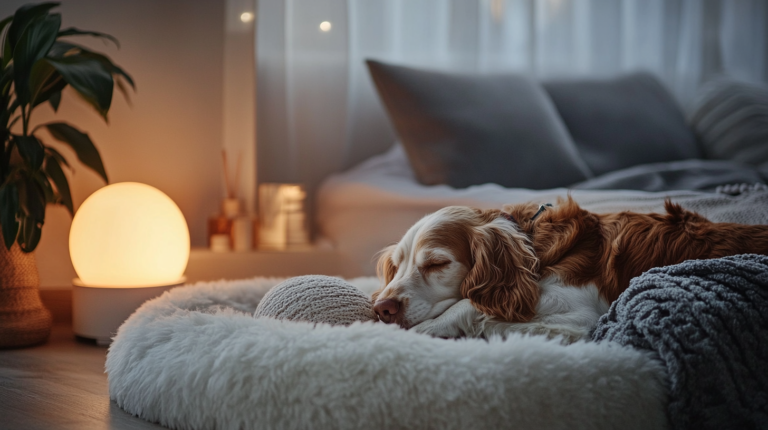

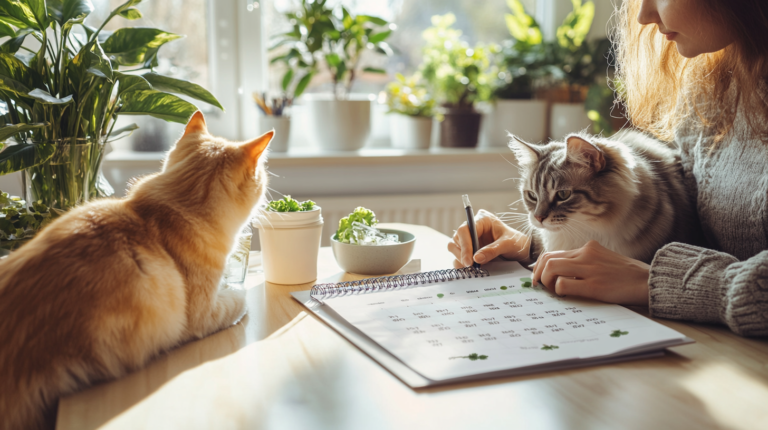



Leave a Reply